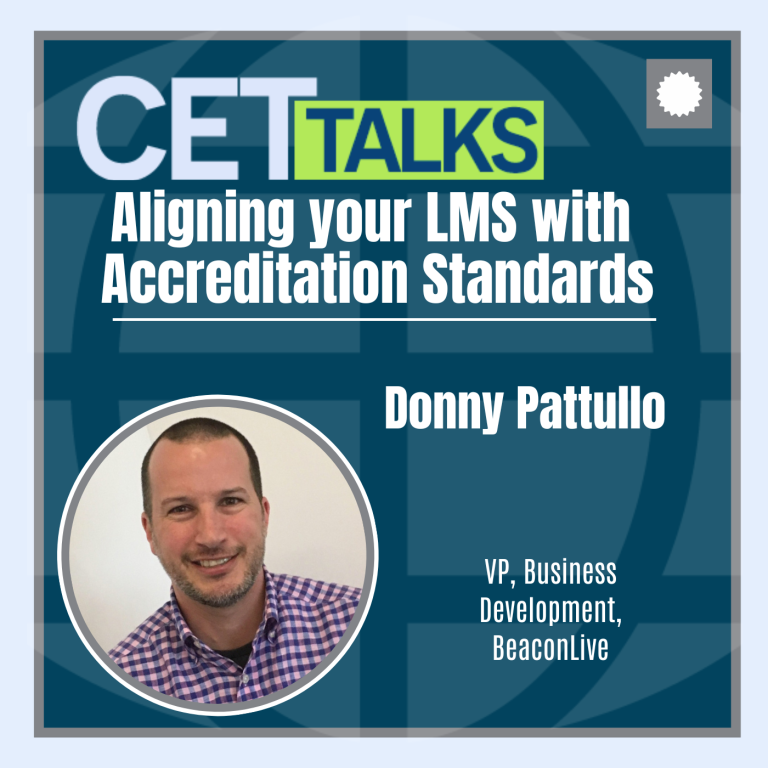Episode 08
.
CET Talks: Accreditation, Learning and Leadership
Episode 08
SEPTEMBER 19 2023 . 25 MINUTES
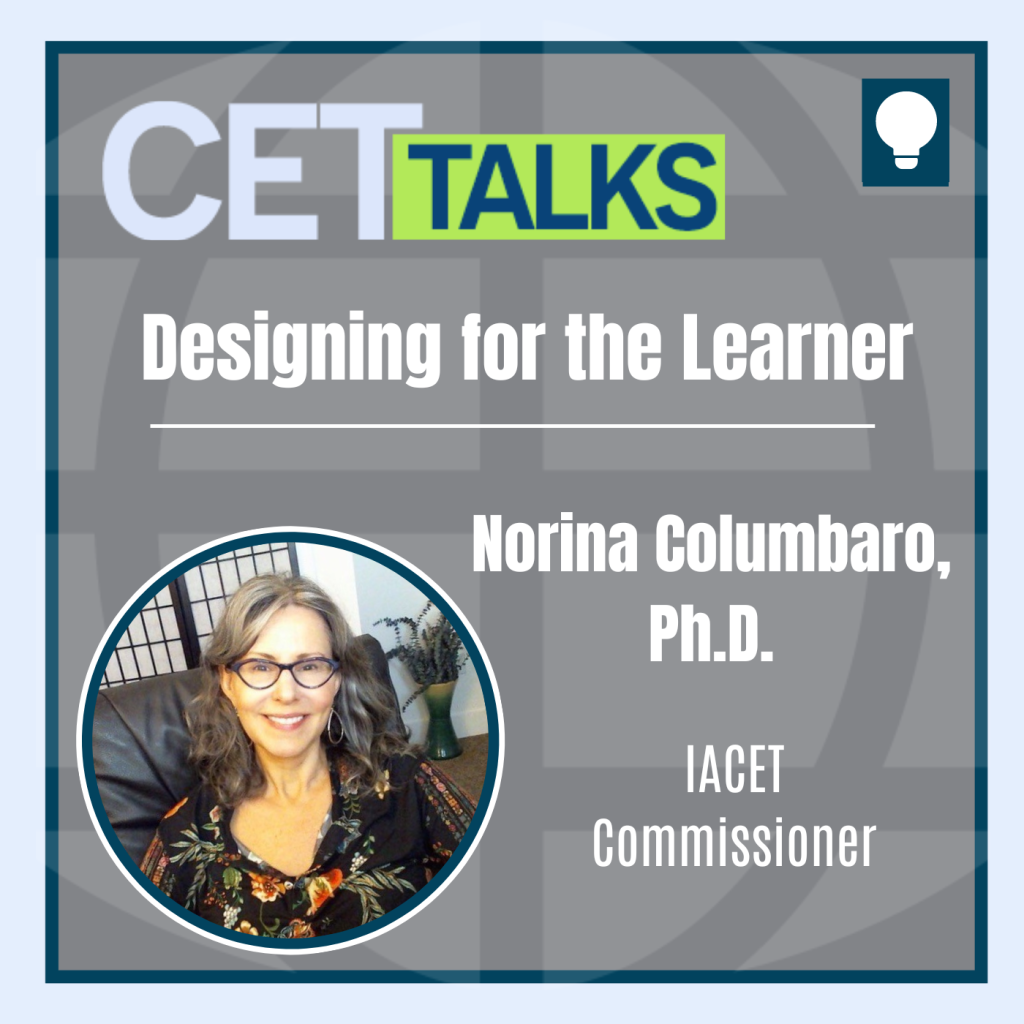
Designing for the Learner: Expert Insights on Needs Analysis
Randy Bowman, Interim President and CEO of IACET, and co-host, Mike Veny, CEO of Mike Veny, Inc., an IACET Accredited Provider, sit down with Dr. Norina Columbaro, Director of Talent and Organizational Development for Performance for Life Consulting, LLC. Norena discusses the crucial role of needs analysis in designing effective training programs. Discover what a needs analysis is, why it’s important, and how the process may evolve with emerging trends like AI. You’ll also hear about how to create an inclusive, accessible learning experience that connects ideas and drives change.
Listen to the Podcast
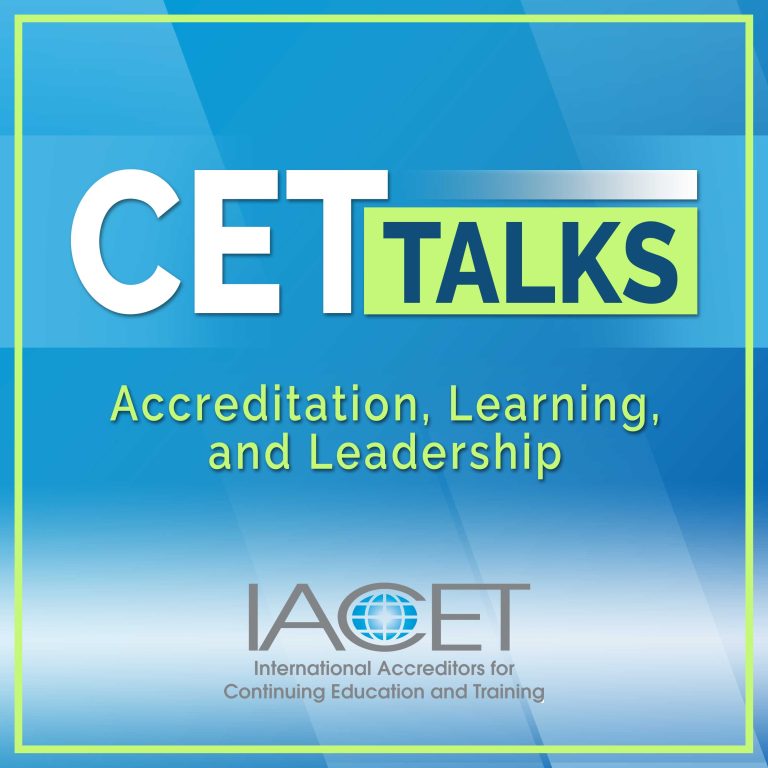
Welcome to CET Talks, the International Accreditors for Continuing Education and Training’s podcast, where we convene thought leaders in the continuing education and training ecosystem to share ideas, research, best practices, and experiences that promote the creation of a world that learns better. Your hosts are Randy Bowman, Interim President and CEO of IACET, and certified corporate wellness specialist Mike Veny.
Randy Bowman, Interim President and CEO of IACET, and co-host, Mike Veny, CEO of Mike Veny, Inc., an IACET Accredited Provider, sit down with Dr. Norina Columbaro, Director of Talent and Organizational Development for Performance for Life Consulting, LLC. Norena discusses the crucial role of needs analysis in designing effective training programs. Discover what a needs analysis is, why it’s important, and how the process may evolve with emerging trends like AI. You’ll also hear about how to create an inclusive, accessible learning experience that connects ideas and drives change.

Transcription
Host: Welcome to CET Talks, the International Accreditors for Continue Education and Trainings podcast, where we convene thought leaders in the continue education and training ecosystem to share ideas, research best practices, and experiences that promote the creation of a world that learns better. Enjoy the episode.
Randy Bowman: Hello, and welcome to CET Talks. My name is Randy Bowman, and I’m here with my co-host, Mike Veny, a certified corporate wellness specialist and CEO of an IACET-accredited provider. Welcome, Mike.
Mike Veny: Hi, Randy. How are you?
Randy Bowman: Doing great. Doing great.
Mike Veny: I’m really excited about our guest today, Dr. Norina Columbaro. She has over two decades of experience as an award-winning talent and organizational development leadership partner and researcher. She’s the Director of Talent and Organizational Development at Performance for Life Consulting, LLC, got her PhD from Cleveland State University in Urban Education, specializing in leadership and lifelong learning, a registered corporate coach, and a certified professional technical communicator. Her research has been published in Adult Learning, the International Journal of Teaching and Learning in Higher Education, the Online Journal of Distance Learning, Human Resource Development Quarterly and Military.com. She is a longtime supporter of IACET. She has served as commissioner, instructor, facilitator standards, council chair, blog contributor, annual conference presenter, and several IACET committees. She has also successfully completed the process to become an IACET-accredited provider, so she knows what it’s like to be an applicant and just every angle of that. I want to take a moment to welcome her, and I want to also let you know that she is a big part of this podcast that you’re listening to. You hear Randy and I all the time, so it’s easy to think that we are the podcast, but what goes on behind the scenes is a lot. Norina helped us get started, and she started actually curating topics and figuring out who the experts were going to be. One thing I always have to remind myself is nothing worthwhile is done alone. I’m really grateful to have her here and to also say before I introduce her, that in curating all this stuff for the podcast, it was an actual needs analysis. So, with all of that, welcome, Norina.
Dr. Norina Columbaro: Oh, thank you so much everybody. I appreciate it. It’s exciting to be here today.
Mike Veny: Well, thank you. So, can we talk about that spreadsheet you created? How did you go about a needs analysis for this podcast and create the list of topics?
Dr. Norina Columbaro: Oh, that’s a great question, Mike. As you said earlier, you don’t do everything by yourself, right? It was definitely a group effort. It really did start with some of the surveys that we had sent out after webinars, after training, to ask people, “What are you interested in? What are some of the topics that you’re interested in?” Starting with a very learner-centric approach, right? What do you want? What do you need in order to do your jobs? Then also scanning the landscape, the ecosystem of CET, and finding out what are some things that are coming down the pipe, what are some things we can anticipate? Then, also from our own experiences talking to people. It was almost like a triangulation of information that informed those podcasts that you’re all listening to.
Randy Bowman: Mike, you’ve dropped this term ‘needs analysis’ a couple times, and that’s what we’ve talked about. But, Norina, what exactly is a needs analysis, especially when it comes to designing and developing training material? Why is it considered a crucial step in the process?
Dr. Norina Columbaro: I’m so glad that you asked me that question, because I’m going to take the standard language of how IACET defines a needs analysis. It’s a method by which one determines the requirements needs, gaps in knowledge, skills, or expectations of a learner prior to a learning event. It was funny because when I was getting ready for this podcast, I actually did a little research on some of our past documentation. I went back into the old principles of good practice and continuing education by Grover J. Andrews from 1984. They defined it in their research, the difference between the current level and the desired level of a learner’s knowledge, skills, or attitude. So to me, we think of a needs analysis as a process, which it is. You need to have a process in place in your organization, whether you’re a Mom and Pop shop, or you are a multi-billion dollar corporation, to find out what is the problem that we’re trying to solve. So regardless, I think the key commonality between these definitions is it’s about the learner; it’s learner centric, it’s creating an experience for the learner so they either can do their job the way they need to do it, or learn some new skills to enrich their lives, whatever their goals are.
Mike Veny: Speaking of learner centric, as a training provider prior to becoming accredited by IACET, I thought that if people were hiring me to come in and train on a topic, then obviously they needed it. In that case, why do a needs analysis?
Dr. Norina Columbaro: I’m so glad you brought that up, Mike. You know what, over the last 26 years that I have been in the field, boy, have I learned a lot of things. One of them is that oftentimes, training and development people are seen as order takers. Organizations will say, “This is what we need.” One of the things I’ve done over the past, probably decade and a half, and it depends on the organization that I work with, is I step back, and I ask them some questions before I say I’m going to develop this training program. I’ll ask some questions like, “What is the problem that we’re trying to solve? And why are we trying to solve it? And who’s involved?” Those three questions just start a conversation. Sometimes they’ll find that they’re trying to fix the wrong problem. That’s why good needs analysis takes planning and stepping back and maybe even challenging the way we’re looking at something. For instance, sometimes we’ll say, “We have a compliance program that we need to update every year. Let’s bring in this training consultant to update it, add some new information, that type of thing.” I’ll go to them, and I’ll say, “Okay, let’s back up a little bit. Let’s back up a little bit. What are some new things that have been happening that may have caused some challenges out in your workplace? What are some of the things that are really giving your learners, the people that actually, the workers that are going to have to execute, the bellyaches?” We really start to step back and ask good questions to find out what the problem at this point in time is, not just diving into automatically working on the content and reworking it. The impacts of that are, as I’m sure you guys probably know, you waste money, you waste time, and you bore the heck out of your learners or frustrate them, even worse. I hope that answered your question, Mike, a little bit of why we do that.
Mike Veny: Absolutely, and it makes training programs more effective. Can you share some examples of the positive outcomes you’ve witnessed when people really embrace this process in an organization?
Dr. Norina Columbaro: Absolutely. I know that I’ve worked on a few projects where I was initially brought in as, as we say, an order taker. And yeah, there’s a place for that every once in a while. What I mean by order takers, they say, “Hey, you know what. We have this training program we need you to create.” And what I found was as I was going along and starting to create that training program without stepping back and really analyzing why we were doing this, who the learners are, and what the changes were in the field; we ended up really missing the mark. Part of the instructional design process, as we all know, is that you conduct a needs analysis, you write your learning outcomes that will inform what goes into your content, and then you find ways to assess the learner’s mastery of that. We found at that point the learners weren’t getting it because we were missing the mark. So we had to back up, and it ended up wasting a lot of time and a lot of money. As I’ve learned more lessons, I’ve been a little more courageous in stepping in and asking those questions now. I use a lot of ‘so that’ statements, too. This is something that has been a practice that has really worked for me. I’ll say, “So that we really give you your return on investment for developing this program; so that we’re really fixing the challenge or creating the solution that you need. Okay?” Not creating what we call an ‘information dump’ for the learners. We make the most of their time. I’m going to back us up. When I go in for needs analysis, I look at the difference that I do now; I used to focus on what we call a training needs analysis. Now I start with a performance needs analysis. It’s more performance consulting where I ask those questions about what they need to do back on the job. There’s some really great resources out there in the last couple years. I do want to share one really great resource that I love is Kathy Moore’s action mapping. It’s a little bit of a twist on the ADDIE model, and it has some elements of SAM, but it really focuses, not on the training needs, but what goes on in the training program. It steps us back; it makes us look at what the performance is that we need to see. What is the change that we need to see? Why do we need to see it? What are the obstacles that are keeping people from making those changes? From that information, we can determine this part might be a training solution, but maybe we need to look at some other things that might be contributing to the issues this organization is having. Maybe it’s the environment, maybe there might be a level of distrust within the environment, and being able to execute what they need to execute; it might be processes. The processes might not be written clearly. It might be the technology that they’re using. Maybe there needs to be an upgrade. So, it really is allowing us to dig a little bit deeper before we get into the actual training needs analysis.
Randy Bowman: Yeah, that sounded great, but you dropped two terms. Just for those people who are listening who may not be deep into instructional design, you said ADDIE and SAM as design modules? Can you talk a little bit about those?
Dr. Norina Columbaro: Absolutely. Two of the main instructional design models that many people are using, and those of you that might be new to the training and development space, ADDIE, is analysis, development, design, instruction and evaluation. It’s the different phases of the instructional design process. So analysis is the needs analysis phase. It’s figuring out what you are doing, why are you doing it, and who are you going to do it for, basically. From there, that informs how you develop your learning outcomes, framing things up, or actually designing and then developing your instructional methods; whether it’s going to be lecture, whether it’s going to be virtual or not, whether it’s going to be asynchronous or a synchronous experience. Then you assess the learners and find out if they are achieving those learning outcomes, and then evaluating how well the program goes. That’s one instructional design model, and most of us know about that one. The IACET standard is very closely aligned with that, for those of you that are APS or applicants. The SAM model is more for e-learning. I think it’s Michael Allen who came up with that particular model. It’s a relatively new, and it’s iterative design. It’s kind of ADDIE accelerated, in some ways. I’m sure somebody’s probably going to come back at me and say, “No, it’s not.” But to me, that’s the way I picture it. They both have a common thread there. There’s some type of needs analysis. You’ve got to start with the end in mind. I always like that statement. I know it seems a little over warm, but I add a little bit to it. Start with the end in mind with needs analysis, but start with the end in mind mindfully, and that’s where you’re going to be more successful. So, Randy, thank you for reining me back. Did that help a little bit?
Randy Bowman: That’s great. Thank you. And I think we got a couple more topics for some other podcasts to bring in some people to talk about these in more detail. I guess there’s a lot of stakeholders that might be involved in doing a needs analysis. Who are the key stakeholders and how do you weigh their input? How does their input contribute to making sure you are creating relevant and targeted training?
Dr. Norina Columbaro: Oh, I love that question because this is where we bring in people, right? With people, everybody has their own agendas and their own power differentials, and that can add a little more complexity to the needs analysis process. Before I tell you what some of my best practices have been, where I’ve seen success, I will tell you there’s a really wonderful resource. It’s a little older, it’s by Ron Cervero. It talks about the planning table, and it does address some of those things about who should be at the planning table, when they should be there, and what are some of the power dynamics that are going to either enable or disable the process. From my experiences, it’s important. When I work with different organizations, and especially instructional designers that are starting up, is if you can get a seat at the table early, in other words, get there before you turn into the order taker, be there during policy changes. Be at that table, working with those executives, senior managers, and stakeholders right away. That way, you can actually help form the content from there. It shows them how important it is to be mindful of the end user or the end learner. So one thing, you’ve got to be at the table too, all right? Obviously the stakeholders, and I think of in a business standpoint, you’re probably going to want your HR person, in some cases, depending on the content or the topic or the domain that you’re concentrating on, maybe senior level CEO, possibly that’s one part of it. Also, you want to bring in subject matter experts. That might be another group, depending on what the topic is or what problem you’re trying to solve. Other times you bring in the actual learners into that process. You can do that through a lot of methods. There’s some other resources, and I’m sure I can share those with you folks after the podcast. But that talks about bringing in the learners, experienced ones as well as not experienced ones. Especially when it comes to anything with equipment training or manufacturing, bringing in people that have been out on the line for a long time and providing some of the best practices. What are some things that we have to look out for? Then, bringing in newer people, and bringing in their ideas of what do I need to know? What’s going to be overwhelming for me? Making that part of your needs analysis, too. Those are some of the people. You can also bring in customers; obviously, you have to be very careful with that, of course. But those are some of the people that need to be at the planning table during the needs assessment.
Mike Veny: For training providers who are listening and co-hosting the show right now, what methods or techniques do you recommend for gathering information during the needs analysis phase? Are there specific tools that have proven to be effective?
Dr. Norina Columbaro: Can I say something before we get into the tools? Don’t get too caught up in them. Don’t find yourself falling in love with the tools too much because that will drag you down. I’m one of those people that believes you need to use the tools, you have to have a process in place, but you need to get something out the door. People, in my experiences, working at instructional design, get too wrapped up in the dogmatic tools. Find something that works for you. So for me, I do anything simply SurveyMonkey. I might use it to develop my needs analysis information. I can use it for the learners, right before the training session. That’s one way; using SurveyMonkey or any other type of survey software. We don’t have proprietary interest in SurveyMonkey, so I just want to say that, too. I’m not getting any kickbacks from them. Sometimes, it’s just a matter of setting up focus groups. You know, we always have that technology that we’re able to do that. That’s one way I’ve been able to get information. I will tell you, the reality is, depending on how many resources an organization has, I’ve had to conduct a needs analysis as late as right when I get into the classroom, because that’s all I have control over. Needs analysis can happen anytime. It could be highly sophisticated with all these wonderful tools I know that I use now, that I’ve learned more about; mind mapping and using action mapping. There’s so much software out there, it could be as sophisticated as that. Or it could be simply asking them at the beginning of the class or that learning experience, “What do you want to get out of this? What’s going to make this a return on investment for you?”
Randy Bowman: Wow, thank you so much, Norina, for your agnostic view of tools. Speaking of tools, we live in a rapidly changing world. Technology and workplace dynamics are constantly evolving. How do you foresee the process of needs analysis evolving? Are there any emerging trends that we should be looking out for that are going to significantly impact how we collect and design needs analysis processes?
Dr. Norina Columbaro: Well, there’s a couple things we need to be more mindful of, in my opinion. Obviously, we’re going to talk about AI ad nauseum, right? AI can assist us with needs analysis. Obviously, we can get out there, we can create these prompts, and then, of course, curate the information that comes out of AI and Chat GPT. That’s going to be something, but also I believe that we have more opportunity to be more inclusive and more open to some different ways of needs analysis. Sometimes, needs analysis can be very obtrusive, depending on culture, depending on background, et cetera. I’ve worked with different organizations, different groups of people, and I’m trying to find ways that I can also conduct a needs analysis that’s impactful, but also respectful of their cultural norms, their cultural needs, and their values, too. I would say AI and being more sensitive and understanding to accessibility, as well as inclusiveness, definitely. More culturally responsive ways of doing that.
Mike Veny: And for the final and most important question, what does a world that learns better look like to you?
Dr. Norina Columbaro: Oh my gosh, it looks like IACET! That’s my short answer for you. To me, a world that learns better means being inclusive and accessible with all learners in mind and focusing on the learners. I always tell my learners, it’s not about perfection, it’s about connection, and it’s focusing on those authentic connections through quality learning experiences and connecting ideas, knowledge, skills, new ways of thinking and change. I always joke with my colleagues that I said it’s looking to world domination. It’s a joke, okay? But joking aside, I truly believe that we can change the world, no matter how small or great a CET organization is that we run. If we’re an OSHA trainer, a childcare educator, a researcher, learning and development professional, DEI, facilitator and champion, we can create a world that learns better. When it comes right down to it, that’s what a world that learns better means to me.
Mike Veny: Well, Norina, thank you so much for this incredible interview, and thank you so much for all your support around this podcast. My big takeaway, Randy, was focusing on the learner, but not really the needs analysis, the performance analysis. What do we want them to be able to do? Also, a term that was thrown out in the beginning, triangulation of information. I love that concept as we’re talking about data or more. What about you, Randy?
Randy Bowman: I really like the idea of design with the end in mind, mindfully. There’s so much correlation between my past as a software developer and designing software and what instructional designers do. That was a key takeaway for me that can be brought into my own field. Thank you, Norina. Norina, thank you so much for your support over the years at IACET. You are definitely a beacon in this organization. We’re glad to have you and thank you for taking the time to speak with us today and share your thoughts, not just with us, but with everyone out there.
Dr. Norina Columbaro: Oh, thank you all. I really appreciate it.
Randy Bowman: After listening to our insightful conversation with Dr. Norina Columbaro about the importance of needs analysis and designing effective training material, we’d love to hear from you. You can help us. You can help us, right? Listen, you can help us do a needs analysis so we can serve you, by letting us know what you are interested in hearing about on this podcast. Use the hashtag #CETtalks, and let’s keep the learning going. We’d love to have you find us on LinkedIn or in Twitter and share your experience and ideas with us. Don’t forget, you can also submit topic ideas, suggestions for guests, and other feedback on our CET Talks podcast page on the IACET.org website. We certainly hope you’ll subscribe to this podcast on your favorite podcast platform, so you don’t miss any episodes. Thank you so much for joining us today.
Host: You’ve been listening to CET Talks, the official podcast of IACET. Don’t forget to subscribe to the podcast on Spotify, Apple podcast, or wherever you listen to podcast. To learn more about IACET visit IACET.org, that’s I-A-C-E-T.org. Thanks for listening, and we’ll be back soon with a new episode.
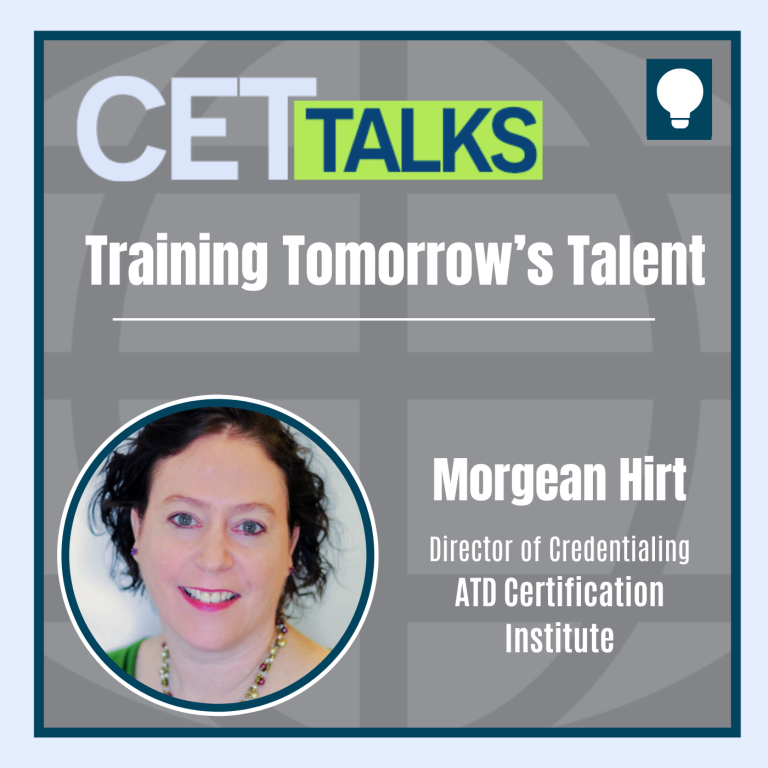
Episode 31: Training Tomorrow’s Talent: Exploring Certification, Standards, and Impact with ATD’s Certification Institute
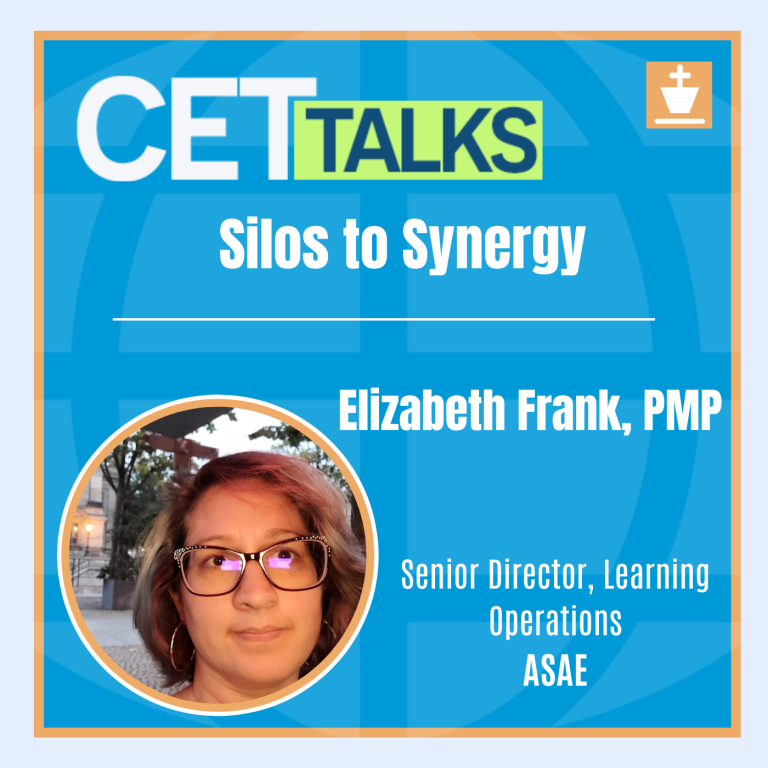
Episode 30: Silos to Synergy: Holistic Approaches to Creating Collaborative Learning

Episode 29: Credentials in Crisis: Challenges and Opportunities in Modern Education Recognition
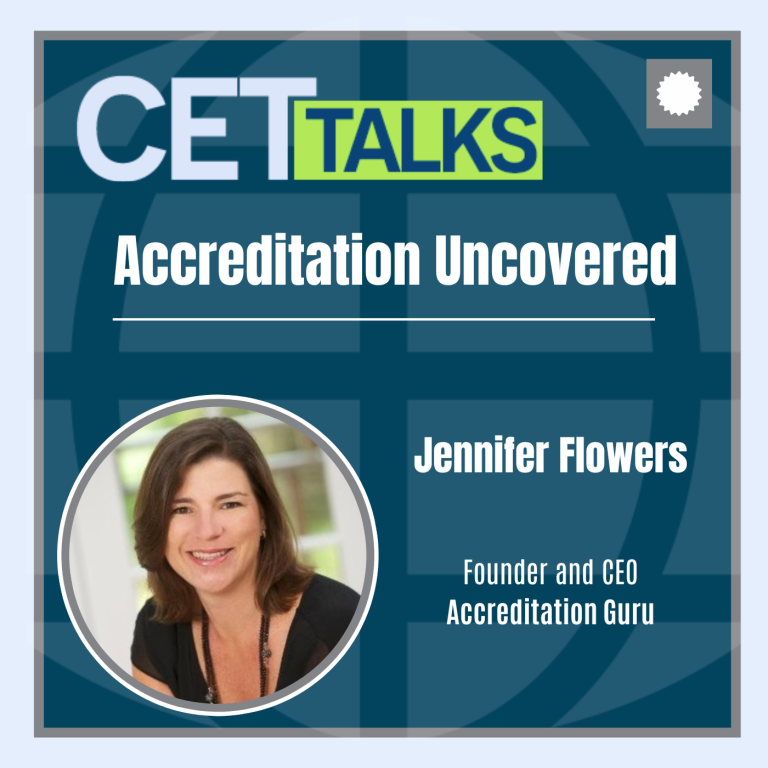
Episode 28: Accreditation Uncovered: Essential Insights from an Industry Leader

Episode 27: Two Truths with a Lie: Managing the Myths of Modern-Day Learning
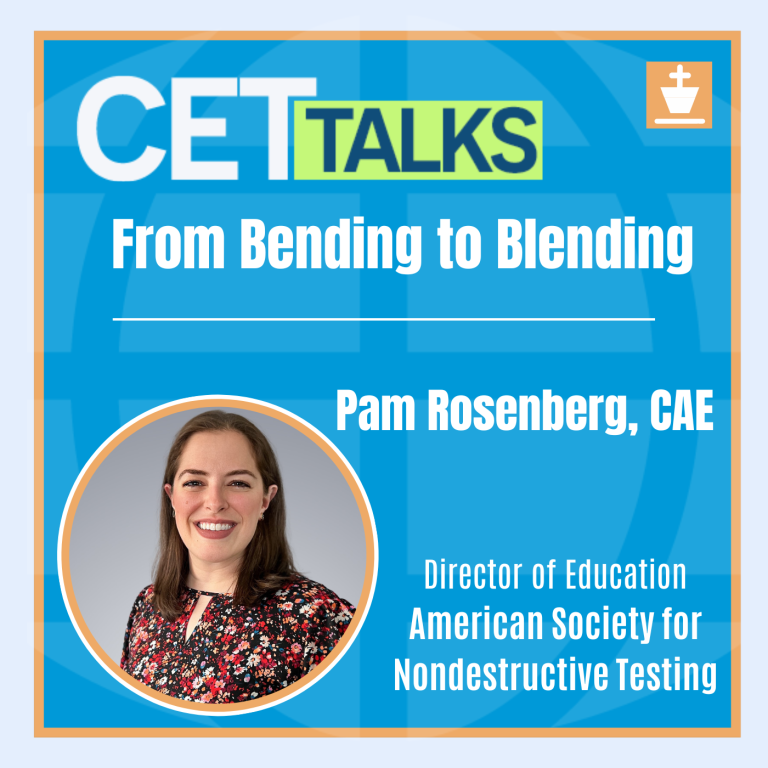
Episode 26: From Bending to Blending: Best Practices in Integrating Externally-Created Content
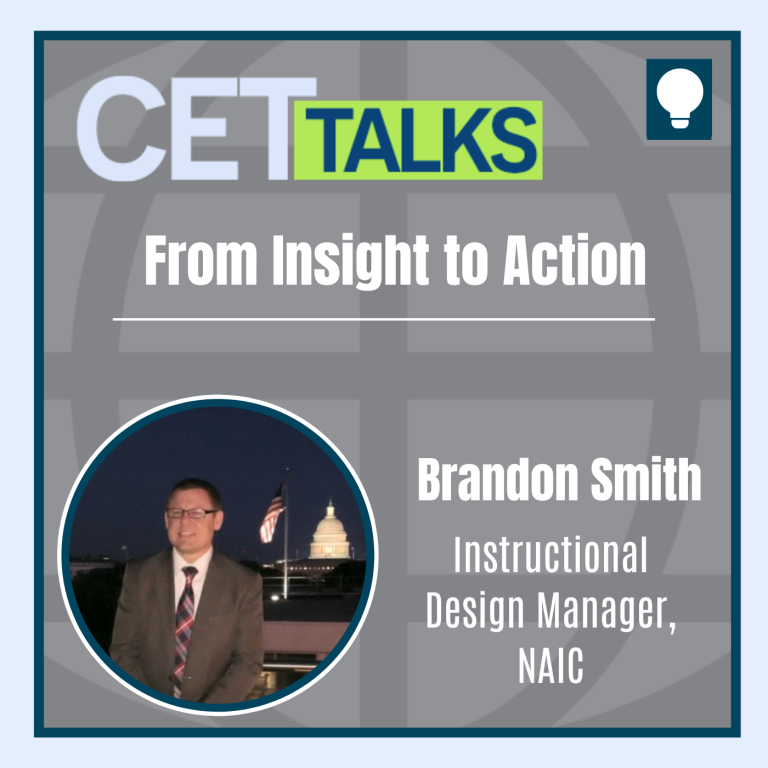
Episode 25: From Insight to Action: Charting the Career Path of a SME-turned-ISD

Episode 24: Cultivating Careers: The Power of Employee Engagement for Organizational Success

Episode 23: Igniting Imagination: Crafting Creativity in Training Environments
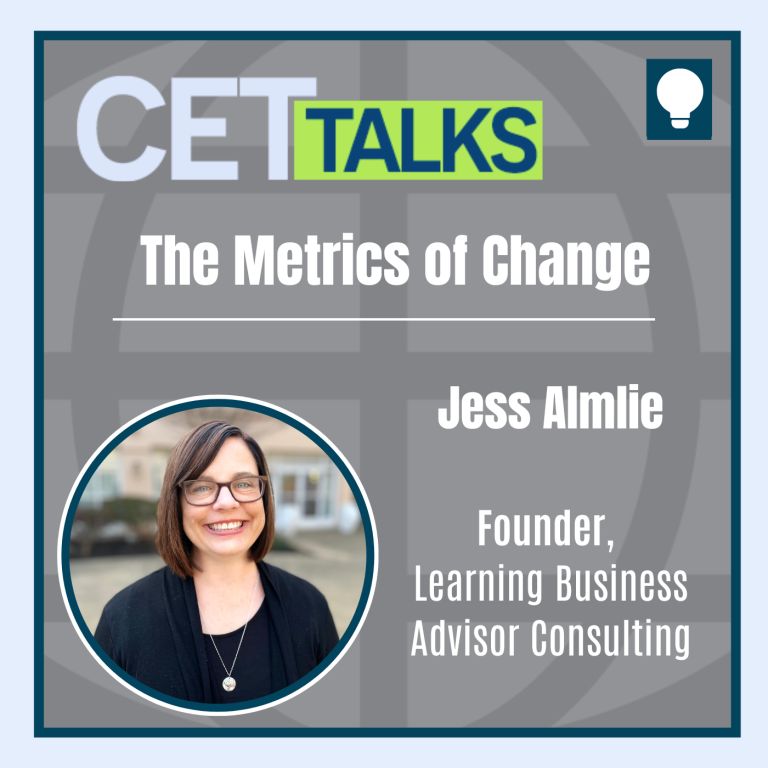
Episode 22: The Metrics of Change: Navigating Purposeful Measurement in L&D
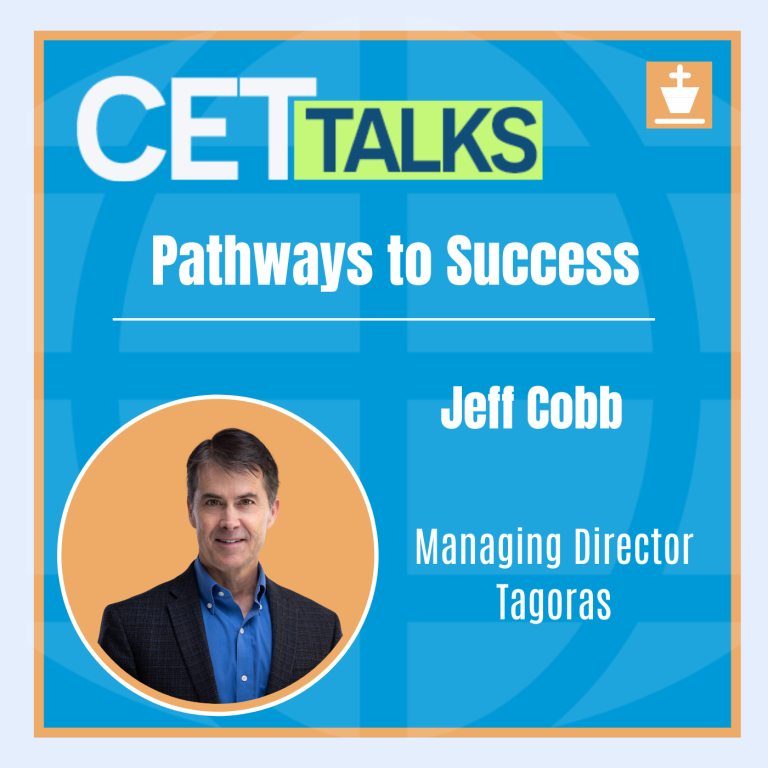
Episode 21: Pathways to Success: The Value of Lifelong Learning through Digital Credentials
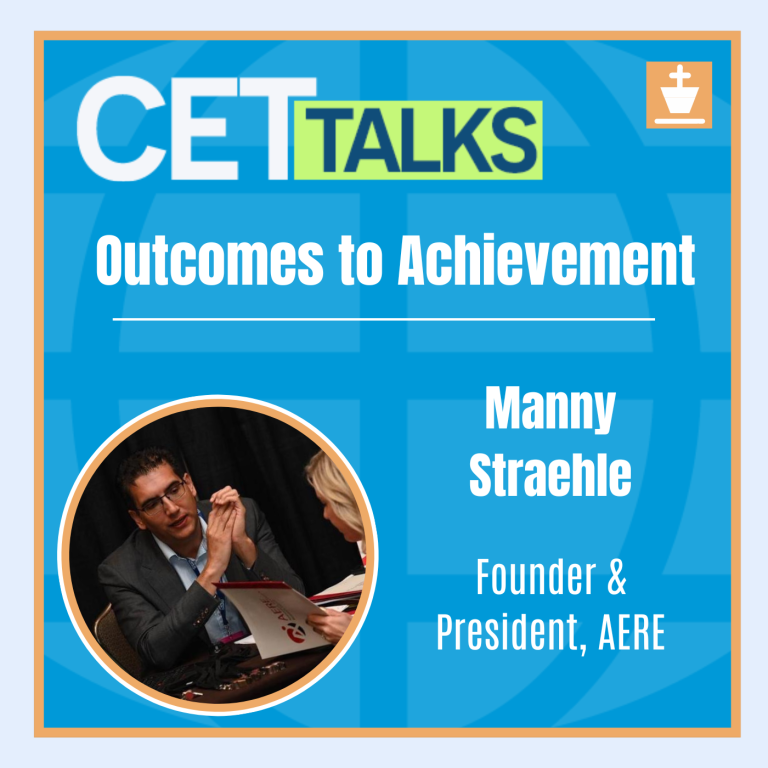
Episode 20: Outcomes to Achievement: Crafting Tomorrow’s Workforce Through Competency Models

Episode 19: Chatting with the Future: Enhancing AI Output Through Prompt Engineering

Episode 18: On the Inclusive Frontier: Harnessing Neurodivergence in Modern Training

Episode 17: Designing with Purpose: Strategies for Accessible e-Learning Development
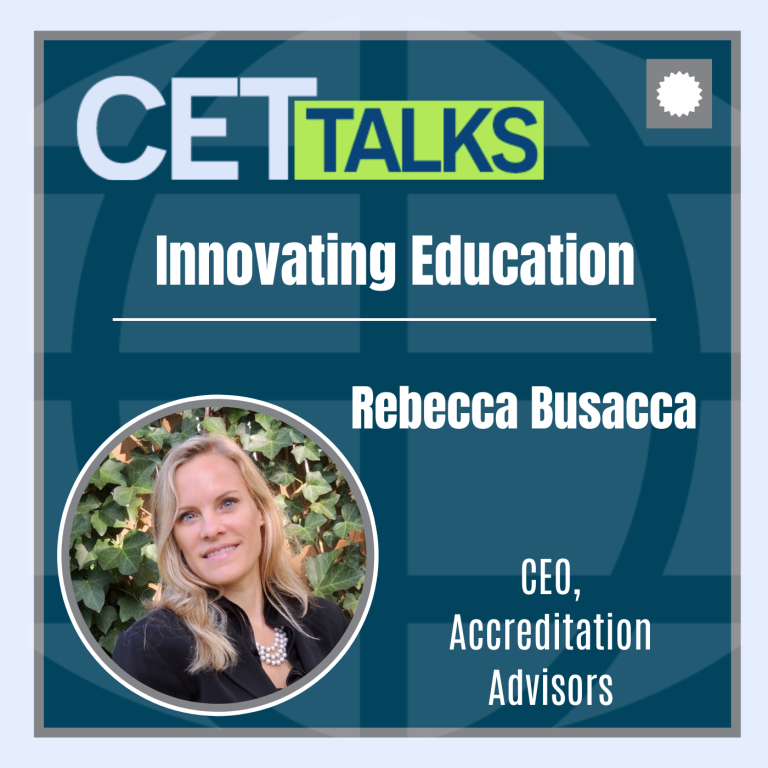
Episode 16: Innovating Education: Navigating Accreditation for Short-Term Training
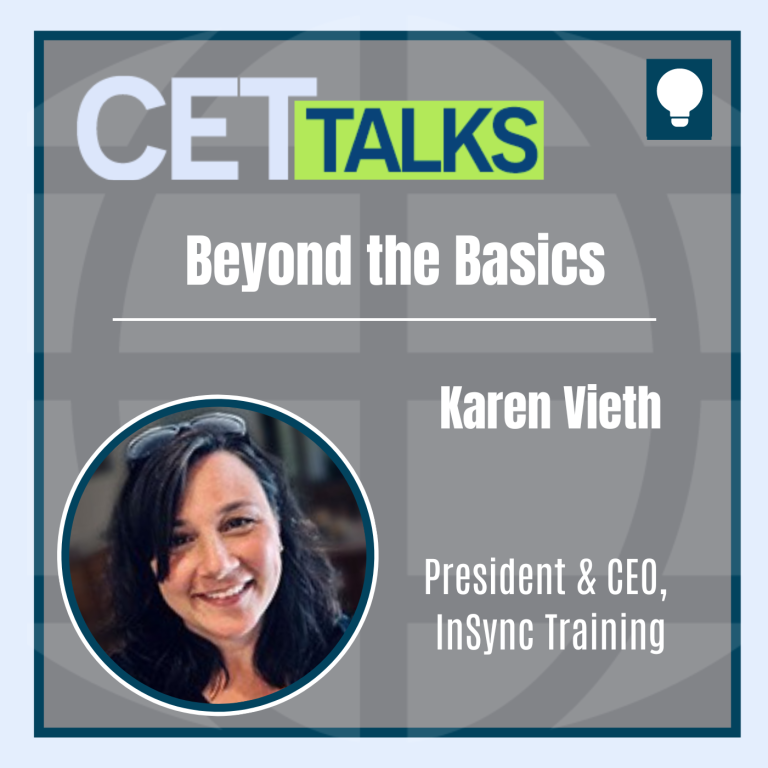
Episode 15: Beyond the Basics: Elevating Virtual Training through Expert Facilitation
